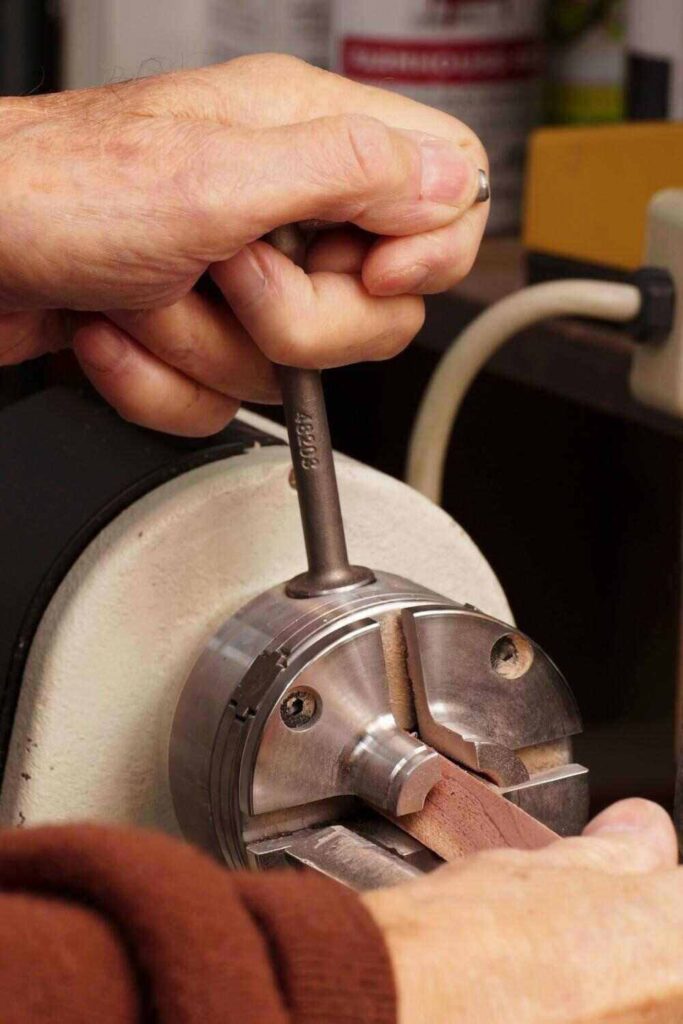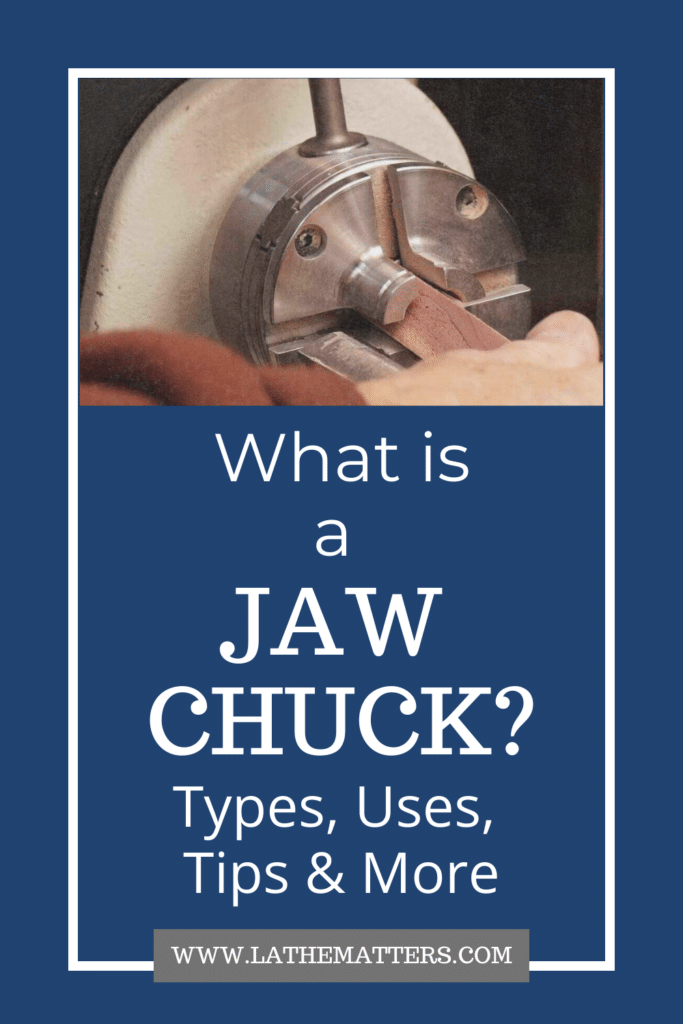Disclaimer: As an Amazon affiliate, I may earn a small percentage from qualifying purchases. This is at no extra cost to you. Learn more here.
Now that we’ve covered what a lathe chuck is, let’s talk about jaw chucks. A lathe jaw chuck is a type of lathe chuck with adjustable “jaws” that grip your workpiece. Since you can’t physically hold your project while it turns on the lathe, a jaw chuck is like having a strong, precise hand hold it steady.
Jaw Chuck Parts
Body
This is the main part of the chuck. The body attaches to the lathe spindle. Need a refresher on the lathe spindle? Our post on parts of a lathe machine can help.
Jaws
The jaws of a jaw chuck are moving parts that come in contact with your workpiece. They can be adjusted to fit different sizes and shapes of wood or metal. The parts of the jaw that move can vary from one jaw chuck to another. We’ll cover the different types of jaw chucks below.

Adjustment Mechanism
The jaws are adjusted one of two ways depending on the jaw chuck. The jaw chuck’s jaws are usually adjusted using a chuck key. Adjusting the jaws moves them in and out or opens and closes them. How the jaws move depends on the type of jaw chuck which we review below.
Types of Jaw Chucks
There are three main types of jaw chucks:
Scroll chucks
A scroll chuck has a single screw mechanism that moves all the jaws simultaneously. Scroll chucks are great for holding round or irregularly shaped wood or metal. Examples of scroll chucks include two types of self-centering jaw chucks:
- 3-jaw chuck
- 4-jaw chuck
Collet chucks
A collet chuck uses a sleeve (also referred to as a collet) to hold the workpiece. Collet chucks are more precise. They are great for smaller, more uniform pieces of wood or metal. For more on this, check out our post on types of collet.
Independent or Combination 4-jaw chuck
Wait, a 4-jaw chuck is listed above as a scroll chuck! Good eye! That’s correct. But only self-centering 4-jaw chucks are scroll chucks. The jaws of an independent 4-jaw chuck can be adjusted individually. Therefore it is not considered a scroll chuck. Independent 4-jaw chucks provide a superior grip on irregular workpieces. Typically, self-centering and independent jaw adjustment are distinct and separate functions. However, some 4-jaw chucks offer both types of jaw adjustment. These are called combination 4-jaw chucks.
How to Use a Jaw Chuck
Mount the Chuck
Attach the chuck to the lathe spindle. Usually, the chuck comes with mounting screws. In some cases, if your lathe is setup for it, you can have a threaded chuck for easy, time-saving mounting. Be sure to check out our post for lathe chuck mounting methods.
Insert the Wood or Metal
Place your piece of wood or metal into the chuck.
Adjust the jaws
Use the adjustment mechanism to tighten the jaws around the wood or metal. The adjustment mechanism is usually a chuck key. Make sure the jaws are snug but not overly tight. Overly tight jaws can damage your workpiece.
Tips for beginners
A lathe does not come with chucks. They are an accessory purchased separately. Once you have your chuck:
Check Alignment
Make sure the wood or metal workpiece is centered and balanced in the chuck. This will help avoid vibrations and uneven cuts.
Tighten Evenly
Tighten the jaws evenly to prevent the workpiece from shifting. Be careful not to over-tighten. Otherwise you may damage your wood or metal.
Practice
First, get a feel for how tightly to clamp the wood or metal. A workpiece that is clamped too tight can cause issues, and if it’s too loose, it might slip. Once mounted and tightened, don’t start on the piece right away. Instead, safely turn the machine on, set it to a low speed, and watch how the workpiece rotates. If all looks good, gradually increase the speed. If there is any wobbling or the setup looks otherwise off, stop the lathe machine and make adjustments.
In summary, jaw chucks provide precision and control. They are extremely useful for woodturning and metal turning. Depending on the specific requirements of your turning project, each type of jaw chuck offers different benefits.
Which jaw chuck do you prefer? Let us know in the comments below.

